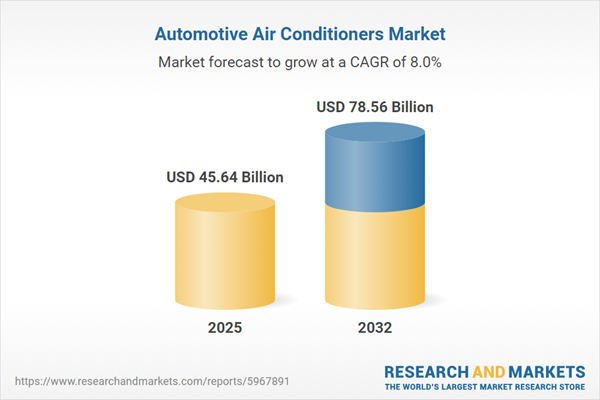Speak directly to the analyst to clarify any post sales queries you may have.
The automotive air conditioners market is transforming as advanced climate control becomes essential for energy-efficient, connected, and electrified vehicles. Senior decision-makers require actionable insights to respond to regulatory, technological, and consumer-driven shifts reshaping the landscape for both passenger and commercial vehicles.
Market Snapshot: Automotive Air Conditioners Market Overview
The Automotive Air Conditioners Market grew from USD 42.37 billion in 2024 to USD 45.64 billion in 2025. It is expected to continue growing at a CAGR of 8.02%, reaching USD 78.56 billion by 2032. Key growth factors include fleet expansion, vehicle electrification, and stronger environmental regulations guiding adoption of sustainable solutions. Strategic priorities are shifting as air conditioning systems now directly impact vehicle performance, brand differentiation, and occupant well-being.
Scope & Segmentation of the Automotive Air Conditioners Market
This market research comprehensively covers automotive air conditioning systems across major segments, components, regions, and leading companies. It provides a clear segmentation for tailored strategy and investment planning.
- Technology: Automatic air conditioners, manual air conditioners.
- Product Type: Expansion valve system, fixed orifice tube system.
- Component Type: Compressors (rotary and scroll), condensers, evaporators, expansion valves, refrigerant.
- Vehicle Type: Commercial vehicles (heavy and light), passenger cars (hatchbacks, sedans, SUVs).
- Distribution Channel: Aftermarket, OEMs.
- Regions Covered: Americas, Europe, Middle East, Africa, Asia-Pacific—including prominent national and sub-regional markets.
- Companies Analyzed: Aezion, Air International Thermal Systems, AUTOCLIMA, Autofrost, BorgWarner, Classic Auto Air, ContiTech Deutschland, Daikin Industries, DENSO Corporation, Eberspächer Gruppe, Hanon System, Haugg Kühlerfabrik, HELLA, Hyundai Motor Company, Mahle, Mitsubishi Heavy Industries, Sanden Corporation, Seeley International, Songz Automobile Air Conditioning, Subros, Toyota Industries, Trans ACNR, Valeo Thermal Commercial Vehicles Germany, WAECO Germany, Webasto Thermo & Comfort.
Key Takeaways for Senior Decision Makers
- Technological advancements and evolving regulatory standards are driving rapid innovation and investment in sustainable thermal management solutions for automotive applications.
- Integration of digital controls, connectivity, and predictive maintenance is expanding, supporting enhanced user experience and enabling new service models in the aftermarket and OEM channels.
- Regional regulatory frameworks and consumer demands shape differentiated product offerings, requiring local adaptation by manufacturers and suppliers to capture market share.
- Strategic supply chain realignment—including sourcing diversification and modular product strategies—helps address challenges associated with tariffs and volatile trade policy.
- Adoption of eco-friendly refrigerants, cabin air filtration, and system miniaturization meets both compliance demands and changing customer expectations for health, comfort, and sustainability.
Tariff Impact: Navigating Cost Structures and Supply Chains in 2025
The introduction of targeted tariffs in the United States in 2025 increased complexity and prompted the realignment of global sourcing strategies. OEMs and Tier-1 suppliers have diversified procurement, built new regional capacities, and explored modular repair solutions to maintain continuity and control costs under uncertain trade conditions. Scenario-based planning, supply chain mapping, and enhanced collaboration with regulators and logistics partners are proving critical as industry leaders adapt to evolving tariff environments.
Methodology & Data Sources
This research uses both rigorous secondary and targeted primary data collection. Secondary sources include regulatory filings, patent databases, and technical journals. Primary research comprises executive interviews and industry surveys. Frameworks such as PESTEL and Porter’s Five Forces supported the analysis, with findings cross-verified through triangulation and validation workshops.
Why This Report Matters: Strategic Value for the C-Suite
- Supports decisive entry, expansion, or risk-mitigation strategies in the automotive air conditioning sector by offering unmatched depth on segmentation and market direction.
- Equips leadership teams with verified insights to align R&D, sourcing strategy, and product development with future consumer, regulatory, and technological trends.
Conclusion
Industry leaders face complexity and opportunity as climate control technologies redefine the role of air conditioning in vehicles. This report enables confident navigation of regulatory, supply chain, and consumer-driven changes to sustain credibility and growth in a dynamic global market.
Additional Product Information:
- Purchase of this report includes 1 year online access with quarterly updates.
- This report can be updated on request. Please contact our Customer Experience team using the Ask a Question widget on our website.
Table of Contents
3. Executive Summary
4. Market Overview
7. Cumulative Impact of Artificial Intelligence 2025
Companies Mentioned
The companies profiled in this Automotive Air Conditioners market report include:- Aezion, Inc.
- Air International Thermal Systems, Inc.
- AUTOCLIMA S.p.A.
- Autofrost Pty Ltd.
- BorgWarner Inc.
- Classic Auto Air
- ContiTech Deutschland GmbH
- Daikin Industries Ltd.
- DENSO Corporation
- Eberspächer Gruppe GmbH & Co. KG
- Hanon System
- Haugg Kühlerfabrik GmbH
- HELLA GmbH & Co. KGaA
- Hyundai Motor Company
- Mahle GmbH
- Mitsubishi Heavy Industries, Ltd.
- Sanden Corporation
- Seeley International Pty Ltd.
- Songz Automobile Air Conditioning Co., Ltd
- Subros Limited
- Toyota Industries Corporation
- Trans ACNR
- Valeo Thermal Commercial Vehicles Germany GmbH
- WAECO Germany WSE GmbH
- Webasto Thermo & Comfort SE
Table Information
| Report Attribute | Details |
|---|---|
| No. of Pages | 198 |
| Published | November 2025 |
| Forecast Period | 2025 - 2032 |
| Estimated Market Value ( USD | $ 45.64 Billion |
| Forecasted Market Value ( USD | $ 78.56 Billion |
| Compound Annual Growth Rate | 8.0% |
| Regions Covered | Global |
| No. of Companies Mentioned | 26 |









